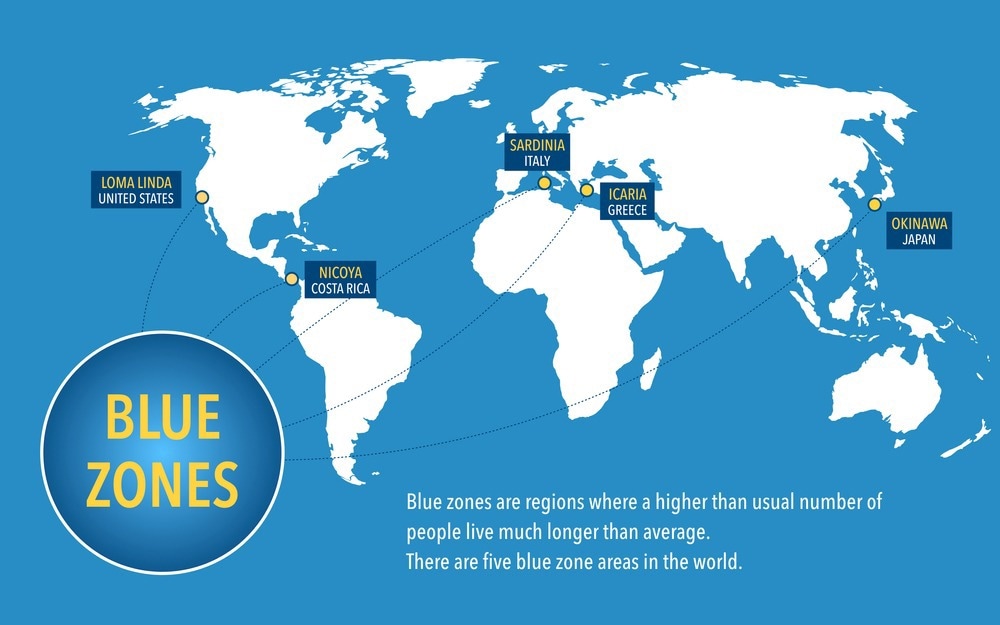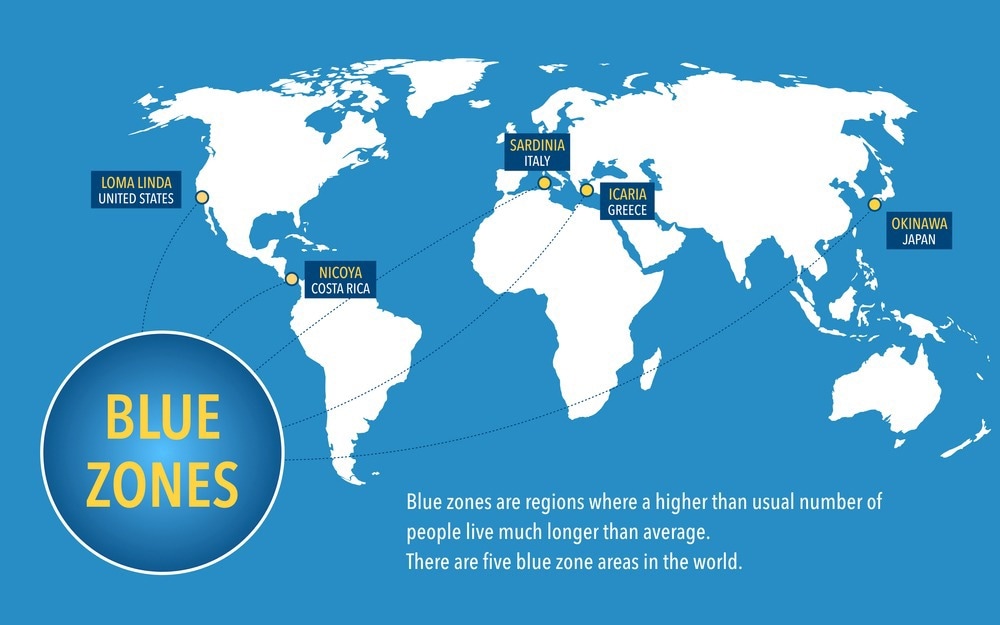
Unlocking the Secrets of Blue Zones: A Blueprint for Longevity and Health
Characteristics of blue zones
The science behind longevity
Blue Zones worldwide
Healthcare implications
The future of aging
References
Further reading
Blue zones are places where there are ten times as many centenarians as expected for a corresponding population size in the USA, most of them being unusually healthy. American researcher Dan Buettner first highlighted Blue Zones, identifying five worldwide, from California to Japan. He called them Blue Zones because he circled these places in blue on the map.
Characteristics of blue zones
The long and healthy lifespan of Blue Zone populations is attributable to lifestyle factors since genetic factors contribute only 20-30% to longevity.
Buettner et al. isolated nine traits and habits of Blue Zone populations – the so-called Power 9.
- People in Blue Zones eat mostly plant-based food. Among omnivorous Blue Zone communities, meat servings come to about 3-4 ounces, and meat is served on average about five times a month.
- Blue Zone communities also habitually fast or restrict their caloric intake.
- Alcohol is avoided or drunk in moderation, mostly red wine rich in antioxidants such as resveratrol and quercetin.
- They have a sense of purpose in life.
- People living in such regions have a lifestyle that encourages natural, vigorous movement. They garden, walk, cook daily, clean, farm, and do other daily chores.
- They incorporate stress relief in a purposeful, regular manner into daily life, whether through prayer, a nap, or a glass of wine with the family.
- Faith is central to Blue Zone communities.
- These communities have stable and extended family structures, with young and old living together in monogamous lifelong relationships.
- Finally, they have supportive social networks that encourage healthy, happy lifestyles.

Image Credit: Dimitrios Karamitros/Shutterstock.com
The science behind longevity
Much research suggests that a strong life purpose imparts hope, improving the quality of life and motivating healthy behavior. In one cohort of approximately 7,000 older Americans, deaths among those with the least sense of purpose were more than doubled vs. those with the most.
The moderate consumption of meat is a marker of a healthy lifestyle and lower cardiovascular disease and cancer rates. Plant-based diets provide an abundance of healthy nutrients, while fish, often a staple among these communities, provides omega-3 fatty acids that promote neurological and cardiovascular health.
Regular fasting or caloric restriction (80% of satiety levels) prevents excessive eating, limiting weight gain, and preventing obesity and related diseases. It shifts cell metabolism towards repair and maintenance pathways rather than growth and reproduction, limiting oxidative stress and inhibiting aging.
Moderate wine consumption is associated with improved cardiometabolic markers and a drop in early mortality risk by 20%.
Notably, these findings may reflect a healthy lifestyle rather than factor-specific contributors to longevity.
Vigorous exercise reduces the odds of heart disease, cancer, and death from any cause. Walking is a good marker of longevity.
Faith-based lifestyles are linked to less depression, stronger social networks, a sense of meaning, and longer lifespans.
Monogamous committed relationships increase life expectancy by up to three years. Family-centered communities provide older people with security, joy, and meaning while protecting smaller children.
The Framingham study supports the importance of social or peer pressure in healthy behavior. This showed that social pressures supported behaviors linked to obesity, smoking, happiness, or loneliness.
Blue Zones worldwide
Buettner described five Blue Zones in his iconic book, The Blue Zones.
Ikaria, a small Greek island, has an average lifespan of 8 years longer than the average American. With low rates of cancer, cardiovascular disease, and almost no dementia, they follow a Mediterranean-type diet, take afternoon siestas, and live stress-free.
The oldest men on earth live in the mountain community of Ogliastra, Sardinia. They are sheep farmers, walking at least five miles up and down mountains. They enjoy red wine in moderation and have low-stress levels.
Okinawa, Japan, is well-known for its women centenarians. They have a soy-rich diet and live stress-free. Their “moai” provide belongingness and support, being groups of five formed in childhood responsible for their members through life. Okinawans practice “Hara hachi bu” (“Stop eating when you’re 80% full”) and “Ikigai” (“sense of purpose”).
In Costa Rica, the Nicoya peninsula community lives well into their nineties with few healthcare costs. They thrive on faith, family, and work, with a characteristic sense of purpose (“plan de vida”). Their water is rich in calcium and magnesium, promoting bone and cardiovascular health.
Finally, the Seventh-day Adventists (SDA) of Loma Linda, California, have many people who continue working in and after their nineties. They have a weekly 24-hour holiday when they rest and enjoy themselves. They are strict vegetarians with family- and faith-centered lifestyles.
Healthcare implications
The key lesson from Blue Zone communities is that a healthy community requires a health-promoting environment rather than more healthcare. Initiatives targeting healthier environments have an oversized impact compared to those that target individual decisions because they encourage a healthy lifestyle by default.
Healthcare professionals must help shape the city and public policies that foster such environments, such as removing fast food restaurants in residential areas and school vending machines.
On a larger scale, city and town councils should mandate healthy environments such as interconnected, no-smoking pedestrian walkways and cycling lanes, both to school or the workplace and to green spaces, encouraging an active lifestyle and active recreation.
Such efforts are credited with having improved the health of over five million people in the USA so far. These projects have steeply lowered obesity rates and smoking prevalence in urban settings. Healthcare expenditure on chronic illnesses has declined, with lower absenteeism rates.
Healthcare professionals can also use this knowledge to motivate healthy social networks that synergize individual health-based decisions. For instance, community farming could be a stress-free, physically active group hobby that produces tangible and useful results beyond the individual.
The future of aging
People over 60 are expected to make up a sixth of the world population in another six years. Longevity studies claim that humans may soon begin to live into their 140s. However, good health continues to elude a large proportion of older people, making the additional years challenging, if not frustrating.

Image Credit: Hyejin Kang/Shutterstock.com
The key insight from the Blue Zones is that aging is inevitable, but deterioration is not if communities use Power 9 values rather than relying on healthcare, caregiving, and infrastructure to support poor health. Individuals cannot build Blue Zones by themselves. However, with support from the government, employers, and health insurance companies, Blue Zone Projects can be, and are being, set up all over the USA.
The aim of these projects is to bring about policy and social network changes that support environmental changes in the local community rather than at the individual level. The motto of these projects is “to not only make the healthy choice the easy choice, but also the unavoidable choice.”
References
- Buettner, D. and Skemp, S. (2016). Blue Zones: lessons from the world’s longest lived. American Journal of Lifestyle Medicine. doi: https://doi.org/10.1177%2F1559827616637066. https://www.ncbi.nlm.nih.gov/pmc/articles/PMC6125071/
- Medawar, E. et al. (2019). The effects of plant-based diets on the body and the brain: a systematic review. Translational Psychiatry. doi: https://doi.org/10.1038/2Fs41398-019-0552-0. https://www.ncbi.nlm.nih.gov/pmc/articles/PMC6742661/.
- Alimujiang, A. et al. (2019). Association Between life purpose and mortality among us adults older than 50 years. JAMA Network Open. doi:10.1001/jamanetworkopen.2019.4270. https://jamanetwork.com/journals/jamanetworkopen/fullarticle/2734064.
- Gepner, Y. et al. (2015). Effects of initiating moderate alcohol intake on cardiometabolic risk in adults with type 2 diabetes: a 2-year randomized, controlled trial. Annals of Internal Medicine. doi: https://doi.org/10.7326/M14-1650. https://www.acpjournals.org/doi/full/10.7326/M14-1650.
- Rimm, E. B. et al. (1996). Review of moderate alcohol consumption and reduced risk of coronary heart disease: is the effect due to beer, wine, or spirits? BMJ. doi:10.1136/bmj.312.7033.731. https://www.bmj.com/content/312/7033/731.
- Panza F., et al. (2012). Alcohol consumption in mild cognitive impairment and dementia: harmful or neuroprotective? International Journal of Geriatric Psychiatry. doi:10.1002/gps.3772. https://pubmed.ncbi.nlm.nih.gov/22396249/.
- Neafsey E. J. et al. (2011). Moderate alcohol consumption and cognitive risk. Neuropsychiatric Diseases and Treatment. doi:10.2147/NDT.S23159. https://pubmed.ncbi.nlm.nih.gov/21857787/.
- Wallace, L. E. et al. (2018). Does religion stave off the grave? religious affiliation in one’s obituary and longevity. Social Psychological and Personality Science. doi: https://doi.org/10.1177/1948550618779820. https://journals.sagepub.com/doi/full/10.1177/1948550618779820.
- Yaribeygi, H. et al. (2017). The impact of stress on body function: A review. Experimental and clinical sciences journal. DOI: 10.17179/excli2017-480. https://www.ncbi.nlm.nih.gov/pmc/articles/PMC5579396/.
- Maddock, C. et al. (2001). How does stress affect you? An overview of stress, immunity, depression and disease. Epidemiology and Psychiatric Sciences. doi: https://doi.org/10.1017/s1121189x00005285. https://europepmc.org/article/MED/11787449.
- Nania, R. (2021). How countries around the world are helping people live better, longer. AARP. https://www.aarp.org/health/healthy-living/info-2021/people-living-longer.html.
- Waldinger, R. J. et al. (2010). What’s love got to do with it? social functioning, perceived health, and daily happiness in married octogenarians. Psychology and Aging. DOI: 10.1037/a0019087. https://drive.google.com/file/d/1wEgx1YaigOilinbKTMhSrKozB6Wf0wNB/view.
- Calorie restriction and fasting diets: What do we know? (2018). https://www.nia.nih.gov/news/calorie-restriction-and-fasting-diets-what-do-we-know#human.
- You, W. et al. (2022). Total meat intake is associated with life expectancy: a cross-sectional data analysis of 175 contemporary populations. International Journal Of General Medicine. doi: https://doi.org/10.2147%2FIJGM.S333004. https://www.ncbi.nlm.nih.gov/pmc/articles/PMC8881926/.
- Ageing and health (2022). https://www.who.int/news-room/fact-sheets/detail/ageing-and-health.
Further Reading
- All Aging Content
- Dysbiosis and Aging
- Do NAD Boosters Help You to Live Longer?
- Homelessness and Aging
- The Role of Senescent Cells in Disease
Last Updated: Sep 20, 2023

Written by
Dr. Liji Thomas
Dr. Liji Thomas is an OB-GYN, who graduated from the Government Medical College, University of Calicut, Kerala, in 2001. Liji practiced as a full-time consultant in obstetrics/gynecology in a private hospital for a few years following her graduation. She has counseled hundreds of patients facing issues from pregnancy-related problems and infertility, and has been in charge of over 2,000 deliveries, striving always to achieve a normal delivery rather than operative.